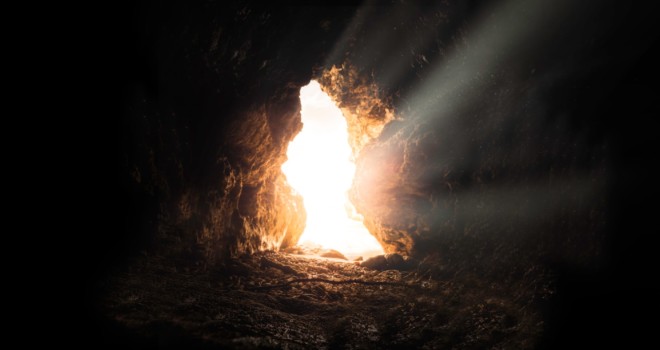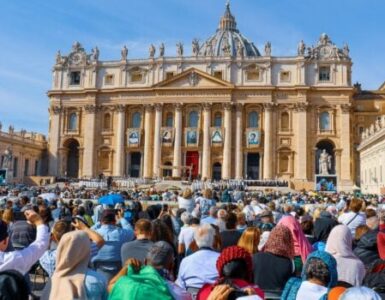Part 38 of This Present Paradise: A Series of Reflections on St. Elizabeth of the Trinity
(Start with part 1 here.)
Death from Addison’s disease would normally come in three months; Elizabeth’s crucifixion lasted more than ten. She once said she thought she would “have a very long purgatory,” (L 224) and it must have often felt that she was living one on earth.
Nine days before her death, Elizabeth’s pain and weakness worsened considerably. She was confined to her bed, barely able to see or speak, gradually starving to death.
Physically and spiritually she was breaking from the world with total inner freedom, waiting only for the Bridegroom to come for her, and ready to wait as long as necessary. She wanted His will even more than she wanted to see Him face-to-face.
Like a wise virgin, her lamps were lit. At times in the final week there was no other interior light. All inner consolations were extinguished so that the final offering would be complete, and she could unite herself even to the anguished feelings of the abandonment of Jesus on the Cross. But she never lost her composure. In the supreme witness of her final, joyful suffering, she modeled what Pope John Paul II called a ‘superior gospel’: the gospel of suffering. That is, thunderous witness to the unshakable truth of Christ—whether we feel it or not—with just one thing: peaceful, joyful surrender in the face of unspeakable suffering.
To use a phrase she had picked up from St. Catherine of Siena, Elizabeth was being “distilled” drop by drop for the Church she loved. This is how a life becomes not only an offering but a sacrifice to the point of holocaust, meaning a sacrifice which is not partial by which is given totally, consumed as if by fire until nothing remains. In the end, Elizabeth became the smoke of incense in her great culminating act as a ‘praise of glory.’
“When a great suffering or some very little suffering is offered to us, oh, let us think very quickly that ‘this is our Hour,’” wrote Elizabeth, “the hour when we are going to prove our love for Him who has ‘loved us exceedingly.’” (L 308) This was her hour, the hour comes for all of us, and now for Elizabeth, was creeping toward a twilight, inching its way to the eternal day, which from all eternity has belonged wholly to God. “Evil may have its hour,” said Archbishop Fulton Sheen, “but God will have His day.”
It seemed that in the last few days, the inner darkness lifted and Elizabeth began to see glimpses of heavenly daylight in her dreams. The veil with her was evaporating, too. “I am going to light, to love, to life!” were the last, lyrical words she was heard to whisper.
On her final night on earth, Elizabeth began to gasp for breath. By morning, she was calm but the nuns realized that she was about to leave them. They gathered around her bed to say the prayers for the dying. Elizabeth seemed, to Mother Germaine, fixated on something above their heads. And then peacefully, around 6:15 in the morning of November 9, 1906, she dissolved into the company of her “Three.”
She had written not long before to her sister, “When the veil is lifted, how I will be to disappear into the secret of His Face, and that is where I will spend my eternity, in the bosom of the Trinity that was already my dwelling here below.” (L 269)
“In peace she made the gift of her wounded life,” Pope John Paul would say in the homily for the Mass of Beatification.
In peace she made the gift of her wounded life.
Moments later, one of the extern sisters slipped out into the quiet, early-morning streets and made her way to Madame Catez’s house. Elizabeth’s mother must have known what the messenger’s arrival meant, but can anyone be prepared to hear the news of their child’s death?
She cried out in anguish, but she then remembered what Elizabeth had gently instructed her to say when the news would come, and so she knelt bravely and prayed: “My God, you gave her to me, you have taken her back from me, may your Holy Name be blessed.”
Grief and loss, all wrapped together as a part of life. We can’t escape it, yet it was never part of God’s original intent for us. We were not created to say goodbye. Death is the terrible result of sin, and we feel it so deeply and wrenchingly because it tears apart body and soul—both integral parts of our being and what makes us human.
But when we were baptized, we were baptized into Christ, incorporated into His life, death, and His glorious resurrection. What is glory if not absolute triumph? Death defines us no more. It has no more power over us—only a temporary separation of body and soul and for those who remain, the terrible, aching loss of what is visible.
Although unseen, our connectedness is only made greater. And in the instant of Elizabeth’s death, what seemed to disappear—her life—was suddenly simply too real and too bright for human eyes to see.
It was important to Elizabeth that her friends remember the reality of the communion of saints. She would write about it repeatedly. “A Dieu, my dear Antoinette,” she wrote to her friend, “when I am up above, will you let me help you, scold you even, if I see you are not giving everything to the Master? because I love you! I will protect your two dear treasures and will ask that you be granted everything needed to make them two beautiful souls, daughters of love! May He keep you wholly His, wholly faithful; in Him I will always be WHOLLY YOURS.” (333)
Yes, Elizabeth, please help us from heaven—we have so much need of your friendship and the graces God has given you to share with us. We have much to be saved from, sorted out, strengthened in, and yes, even scolded for! Somehow we know this: that you are more present, more loving, more alive, more ours, more Elizabeth than you have ever been.
“You will be very present to me there, and my happiness will grow in interceding for you whom I love so much.”
(L 341)
Editor’s note: This article originally appeared on SpiritualDirection.com and is reprinted here with kind permission.
Image courtesy of Unsplash.










